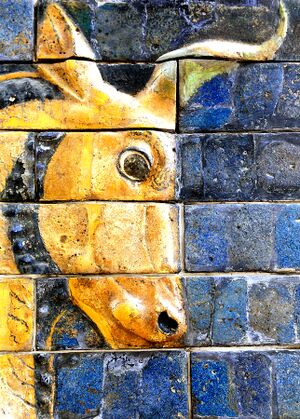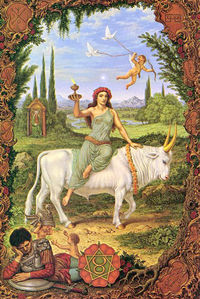Taurus

Symbol: 
Tarot key: The Hierophant
Sun in Taurus: from about 21st April to the 20th May
Season: The splendour, beauty, scents, and sound of Spring.
Culture: Walpurgis Night, May bank holiday, maypole, Ascension Day
Physical Body: Mouth, gullet and oesophagus, throat, neck (and sometimes shoulders)
Star constellation: Taurus

Mythology of the star constellation
Liz Greene[3]: The bull is one of the most ancient symbols of the strength and fertilizing power of nature. All over the Mediterranean and the Middle East, the bull was worshiped as the consort of the earth goddess, and a vivid portrayal of these rites comes down to us in the frescoes of the bull dance, so beautifully portrayed at Knossos, in Crete. The animal's blend of slow, patient movement, and terrifying power when angered, epitomized the benign and destructive faces of the forces of nature.
When Zeus desired the beautiful Phoenician princess, he transformed himself into a magnificent white bull. After enticing her to sit on his back he rose and fled with her to Crete where he revealed his true identity and took her as his lover. Minos, who was one of their sons, became the king of Crete. During a dispute with his brothers he called on Poseidon to help him and the latter agreed in return for a fitting sacrifice. For this purpose Poseidon had a pristine white bull rise from the waters but Minos was so taken with the bull that he was unwilling to sacrifice it. Poseidon took revenge for this broken oath by causing Minos' wife Pasiphae, who was the daughter of the sun god Helios, to fall in love with the bull. Pasiphae had the Athenian artificer Daedalus construct a hollow wooden cow in which she could hide in order to copulate with the bull. She then gave birth to the Minotaur, a monstrous creature with the upper body of a bull and the lower one of a human. The Minotaur demanded human sacrifices and so was kept in a labyrinth built by Daedalus to protect the inhabitants of Crete. Eventually, Theseus managed to kill the Minotaur with the help of Minos' daughter Ariadne.
A further myth associated with the constellation of Taurus concerns Io, the daughter of Inachus. Zeus also took her as a lover and transformed her into a cow to protect her from the fury of his wife Hera.
The Greek god, Poseidon, ruler of earthquakes, was worshiped in the form of a giant black bull who lived in the depths of the earth and shook the ground when he stamped in anger. Here, the raw forces of nature are perceived as inimical to the heroic will, for instinctual compulsions erode self-reliance and undermine the capacity to direct one's life.
In the Mithraie mysteries of the late Roman Empire, the bull became the clear symbol of primitive human passions, which had to be sacrificed to open the door to a higher level of consciousness.
The Buddha, according to legend, was born under Taurus, and the image of the taming of the bull feures in many Buddhist tales. Taurus in myth is thus both an embodiment of earth's creative potency, and the eternal challenge of the instincts to the human will and spirit.
Interpretation
Taurus is the second sign of the zodiac. It is concerned with pausing and comprehending the physical world through the senses: taste, touch, sight, hearing and smell. Individuals with an emphasis of this sign in their natal charts are very sensual, passionately devoted to the world of sensual pleasures and are very physical. The basic principle could be described as "the longing to absorb sensually", and both the physical world and the realm of material values play an important role: The motto here is possession or being able to call something my own.
Taurus individuals may be slow to act but their actions are thorough and usually have long-lasting effects. They are reliable and can really get stuck in when they want to. They prefer to be surrounded by people they are familiar with. Their need for security can sometimes cause them to cling to possessions or become jealous and possessive in relationships. Taureans are very patient and have great stamina. This makes them thoughtful, contemplative and calm on the one hand, but can also make them stubborn and inflexible, which can sometimes stand in the way of their own progress. They are conservative and protective and tend to be more interested in what they are familiar with than new and unknown things which have yet to prove their reliability. Their personal boundaries are important to them and they are determined to defend them.
Taurus individuals have an air of calm and are good at persevering during difficult times. If they bottle up their frustrations for too long, they are liable to explode with an intensity that shocks those around them. This shows the potential darker side of this sign which is symbolised by the Minotaur in the Greek myths.
Any planets or axes in this sign of zodiac will exhibit Taurean qualities such as patience, reliability and sensuality.
Taurus shares with the other two earth signs Virgo and Capricorn a sense of what is practically possible. It feels at home in lush green meadows where it can relax and allow its senses to soak up the surrounding nature, whereas Virgo separates the wheat from the chaff at harvest time and Capricorn climbs into the barren heights of the mountains. Taurus shares with its opposite sign Scorpio an interest in physical pleasure, although with Taurus the emphasis is on indulgence and enjoyment of these, whereas Scorpio is more interested in the deeper transformational power of sexuality. The two signs in archetypal square aspect to Taurus can teach it valuable lessons: From Leo Taurus can learn the art of self-presentation, and from Aquarius the ability to be different to others and still belong.
The Moon is exalted in Taurus, Mars and Pluto are in detriment and Uranus is in Fall.
Weblinks
- Taurus, the Bull | Famous Taureans (Deborah Houlding/ Skyscript; at the bottom of the page also audio - Houlding herself speaking, 14min26)
- The Zodiac Suite: "Taurus" by Rebecca Tripp (youTube - Video)
- Sound of zodiac - Taurus (youTube - Video)
Notes and References
- ↑ From Liber Astronomicus by Guido Bonatus, 1491
- ↑ Bull's head at the Ishtargate from Babylon. Built about 575 BC, it became housed in Berlin’s Pergamon Museum in 1930. See britannica.com/Ishtar-Gate and also Exploring Babylon and the Prophecies Against Her (Expedition Bible)
- ↑ Text partly by Liz Greene, from Mythic Astrology

